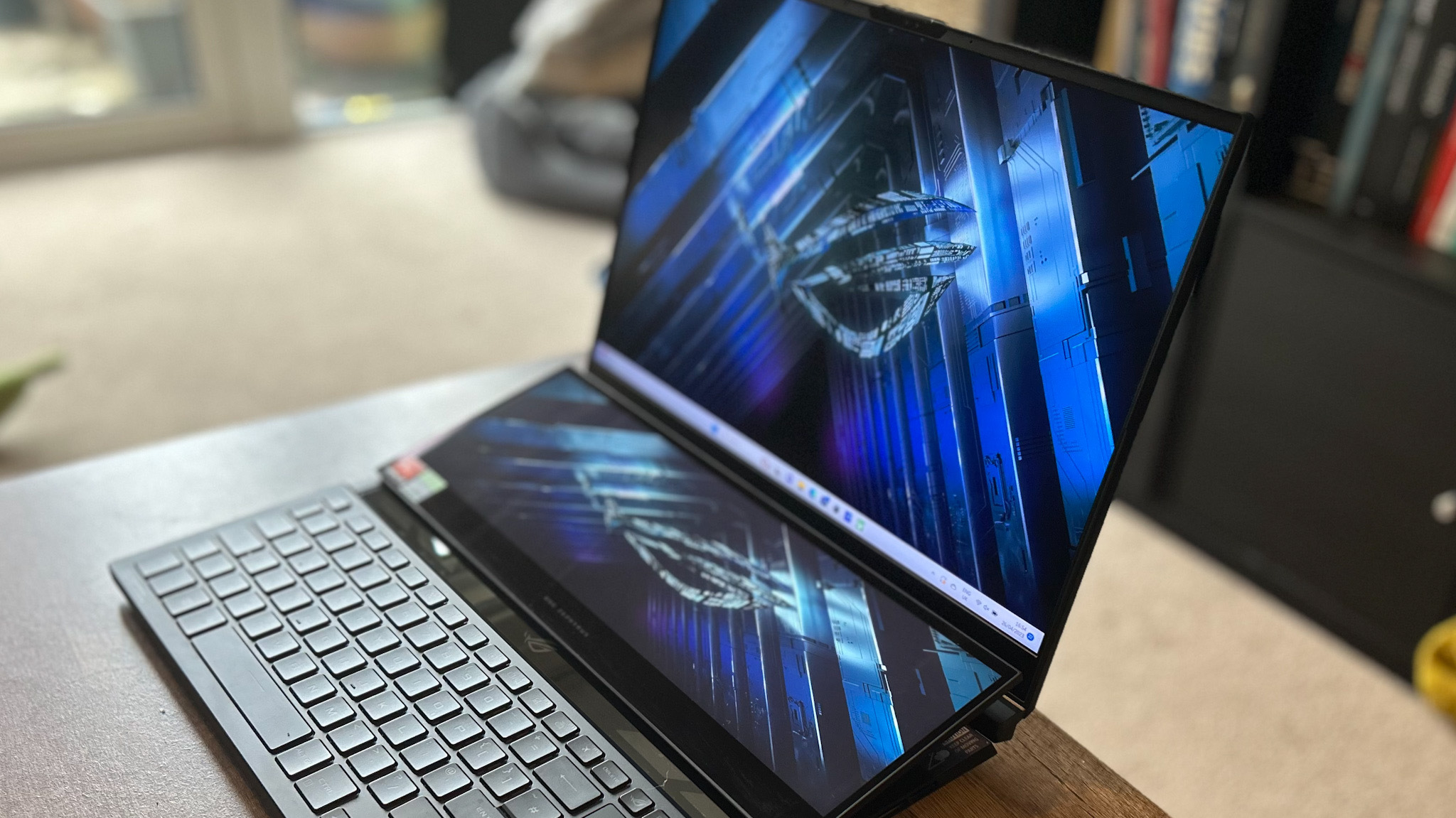GamesRadar+ Verdict
The Asus ROG Zephyrus Duo has done it again. With two screens and a hell of a lot of horsepower, this is an all-in-one work-and-play powerhouse. It's got the performance and display of a high-end gaming device, with the utility and features of a productivity wizard. While that unique design (and price) won't be for everyone, it's certainly one of the best on the market right now.
Pros
- +
Excellent dual-screen design is handy and intuitive
- +
Slick feel despite being heavier than competition
- +
Vivid HDR Mini-LED display
- +
Wide choice of GPU configurations
- +
Incredible performance despite running two screens
- +
Particularly impressive airflow and cooling
Cons
- -
Second screen doesn't work with all games
- -
Heavier than a lot of slimline laptops
- -
Placement of mouse and keyboard might not be for everyone
- -
Particularly expensive
Why you can trust GamesRadar+
While much of the gaming laptop industry follows the same rulebook when it comes to design and form factor, Asus has a commendable habit of breaking the mold. Of course, the two-screen design of the ROG Zephyrus Duo isn't new, these machines were sporting additional displays since 2020. However, with the next generation of high-end components under the hood, and a 2023-worthy MiniLED display, the new model is certainly pushing the boat out once more.
If you're bored of the standard clamshell aesthetic of most of the best gaming laptops on the market, the Zephyrus Duo might be the perfect tonic. The extra display propped up just above the keyboard certainly isn't a gimmick - in fact, it's a productivity dream. Considering Asus hasn't compromised on performance to pack this extra feature in means the Zephyrus Duo is uniquely positioned to offer a best-of-both-worlds experience, combining work and play into one excellent device.
I've spent the last two weeks with the 2023 Duo, and while my configuration will set you back an eye-watering $3,999, I'm confident in recommending it to any big spenders looking for an all-in-one powerhouse with a unique twist.
| Specs | Tested |
|---|---|
| Price | $3,499.99 - $3,999 (Tested) |
| Display | 16-inch QHD+ (2560 x 1600) MiniLED, 240Hz, ScreenPad Plus 14-inch 4K (3840 x 1100) |
| Processor | AMD Ryzen 9 7945HX |
| GPU | Nvidia GeForce RTX 4090 (Tested) | RTX 4080 | RTX 4070 | RTX 4060 |
| RAM | 32GB DDR5 |
| Storage | 2TB PCIe 4.0 NVMe M.2 SSD |
| Connectivity | WiFi 6E, Bluetooth 5.2 |
| Ports | 1x HDMI 2.1, 1x USB 3.2 Gen 2 Type-C (DisplayPort, power delivery, G-Sync), 1x USB 3.2 Gen 2 Type-C (DisplayPort, G-Sync), 2x USB 3.2 Gen 2 Type-A, 1x 2.5G LAN, 1x 3.5mm audio |
| Dimensions | 35.5 x 26.6 x 2.9cm |
| Weight | 2.67kg |
Design
- Dual screen design pushes keyboard down but still comfortable
- Slick feel despite extra heft compared to competition
- Subtle, professional external aesthetic
The Asus ROG Zephryus Duo line is all about the design. You can't pack a secondary display into a gaming laptop without seriously considering the aesthetic, functionality, and durability of the build. That's why it's so refreshing to see the same subtle iconography running along the back of the lid as the previous iteration. There's nothing loud or particularly 'gamery' about this design, and that's an easy trap to fall into when the inside of a machine looks as futuristic as this one. A simple diagonal line with an embossed ROG logo is all you get here, and it's really all you need.

The whole experience was bizarrely comfortable
Under the hood, though, that unassuming aesthetic goes out the window. I've never used any of Asus's dual-screen laptops before, so opening the lid for the first time provided a sense of wonder I haven't felt with a gaming laptop in a long time. The second screen takes up about half the space of the main deck but rises with satisfying resistance as the lid itself opens. Once at its final 13° angle, it sits within perfect eyeline when viewed from a desk or in a laptop position.
The 14-inch screen sits at just under 5-inches tall on top of the main keyboard. That means things look a little different further down. The main keys have been nudged to the very bottom of the deck, leaving no room for resting your palms, with the trackpad positioned at the right-hand side. I was ready to blast this design on first look, already imagining the hand cramps from a vertical trackpad and the strange angle at which I would have to be typing.
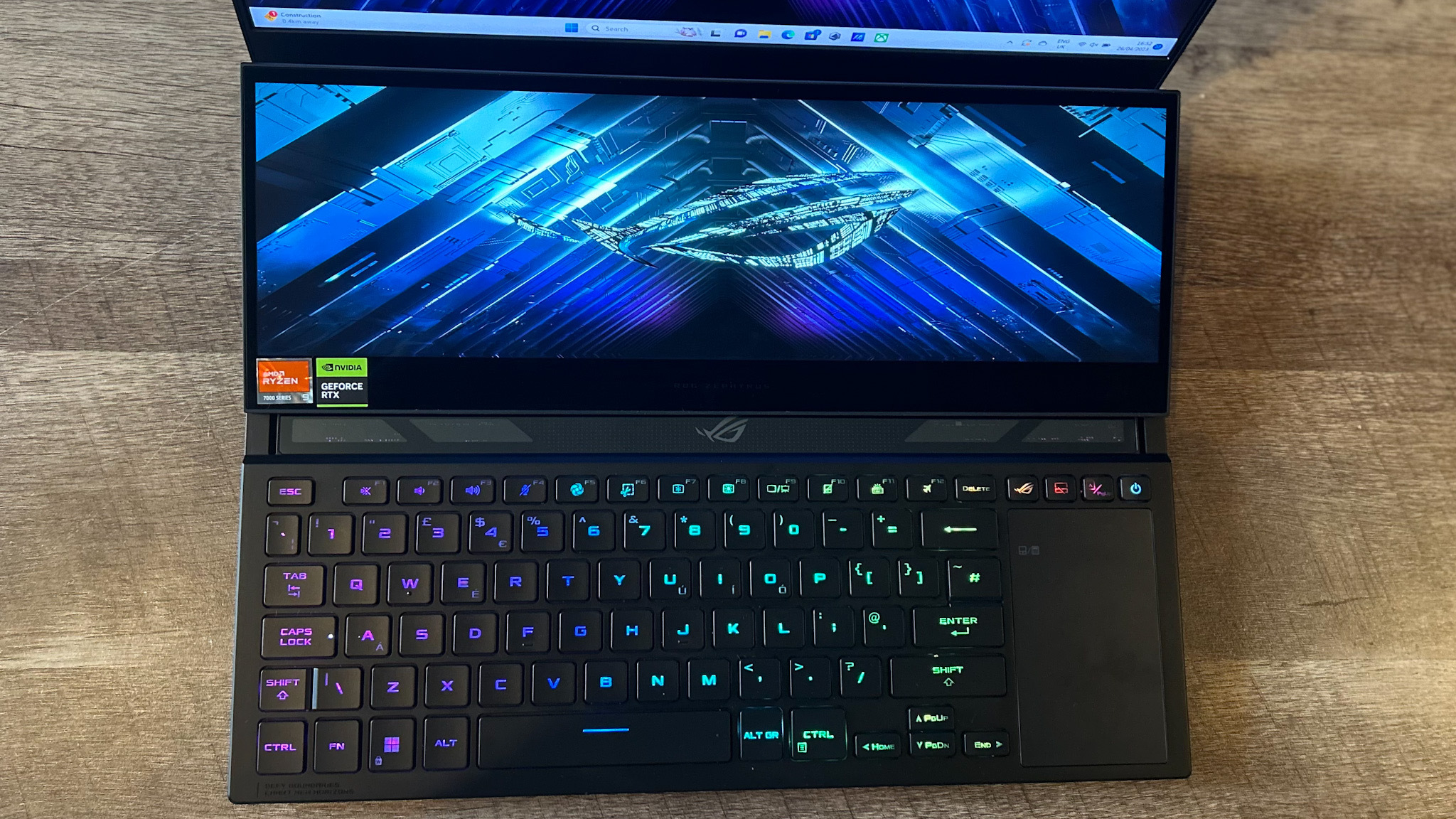
However, the whole experience was bizarrely comfortable. Yes, I had to adopt a new method of using the trackpad when seated in a laptop position, but it certainly wasn't as unnatural as I had first imagined it to be. I was also able to comfortably type on the keyboard for the full work day without shifting my position too far from ordinary. In short, that extra screen doesn't sacrifice your keyboard or trackpad comfort, it just takes some minor tweaks to muscle memory. Of course, it won't be for everyone so it's well worth putting some careful consideration into your typing style if you are looking to invest.
In fact, the tilted angle of the screen actually provides additional cooling. While I did notice performance dropping slightly (and one benchmark test cut out completely) when closing the lid slightly, there's plenty more airflow all around the machine here which is always a bonus.
Despite all those moving parts, the Asus ROG Zephyrus Duo 16 still feels sturdy and durable. In fact, I was impressed with just how slimline this machine is for all its extra features and power-hungry components. Measuring in at just under 3cm thick, it's on the smaller side of current-generation gaming laptops and doesn't pack a cumbersome weight at 2.67kg.

Yes, that's a chunkier laptop than the Asus ROG Strix Scar 16 or the Asus ROG Zephyrus M16, but it just doesn't feel like it in the hand. Perhaps it's the lack of sloped corners or thicker grill sections but the Duo feels far slicker than these lighter machines. That means it suits an office-based setting just as well as a gaming setup, and won't draw the eye unnecessarily when you whip it out of a backpack.
Despite this more streamlined feel, there are still plenty of ports up for grabs - including a selection of the more heavy-duty options lined up on the back. HDMI 2.1, USB-A, and LAN connectors are positioned in the center of this pack panel, keeping them perfectly tucked away when used on a desktop setup. I would have appreciated the USB-C currently located on the right to join them, to allow for a discrete connection to a dock for even better cable management, but I'm still glad to keep the majority of permanent connections tidy.
Features
- Second screen is handy for productivity but less so for gaming
- Detailed and vivid HDR main display
- Wider choice of graphics cards than other 2023 Asus releases so far
Of course, we're going to have to pay that second screen its due attention first. The ROG ScreenPad Plus can be used to keep track of your stats in-game, control and view your chat when streaming, or simply act as a standard additional display during work. It's touch-sensitive as well, which means you won't need to wiggle your cursor all the way down to quickly navigate, and easily reachable when used both on the lap and on a desk. There's plenty of potential in this extra panel, especially considering it boasts a crisp 3840 x 1100 resolution and responds to taps particularly quickly.
I largely used it as I would a second screen in any other scenario, for work. Keeping Slack and emails side by side while splitting the main display as well made for an extremely easy portable work setup. I spent my work week on the sofa to truly test the capabilities of this all-in-one command center and came away impressed. Content creators will also love the touch gestures on offer here, with the ability to dock certain controls and menus to the lower display for fast scrubbing or just easy access.
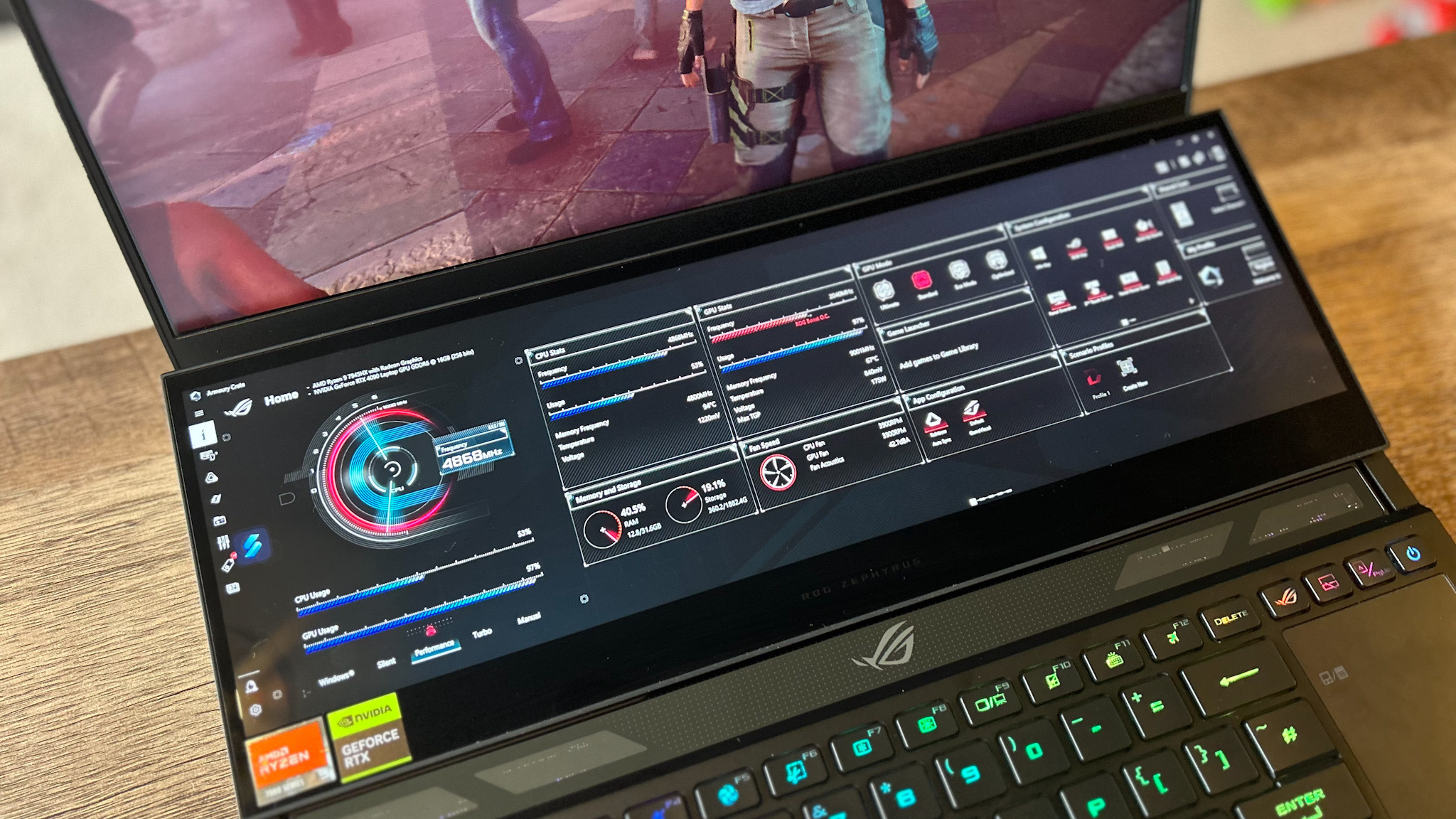
That's all well and good for work. For play, the ROG ScreenPad Plus poses some issues. I regularly lost access to the second screen when booting up certain games, and some simply shunted half the picture off the screen. I was looking forward to kicking back with Planet Coaster and a YouTube playlist, but this proved too much to compute. When gaming, I generally only used the second screen during certain games, and only for monitoring system performance. If you're after a pure-play device, it's likely not going to be worth shelling out for such an experience.
Looking up to the main display is well worth it though. This is a particularly vivid 16-inch 2560 x 1600 MiniLED panel. Not only is that offering excellent color contrast and an impressively detailed picture, but with an HDR 1000 rating, Dolby Vision, and 1,024 local dimming zones it's a dynamic range powerhouse. It needs the right game to truly set it off, but once I loaded up Castle Dimitrescu in Resident Evil Village I was amazed at the warmth and distinction of the tones here. It's also plenty bright with 1,100 nits to its name - this is one of the only laptops I've felt I had to turn down in the evening.
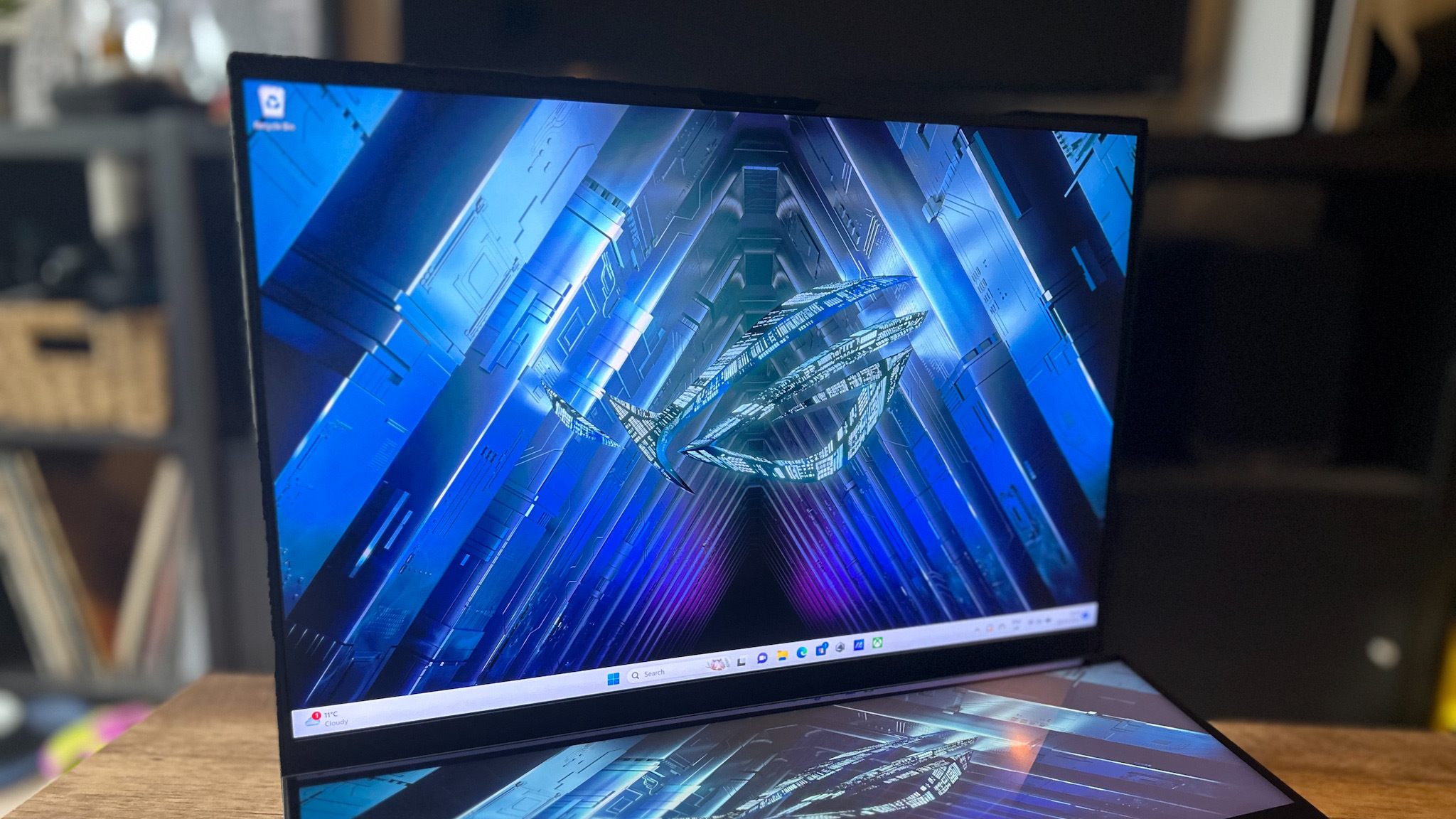
To compliment that excellent display, you'll also find a six-speaker array tucked away under the body, offering richly textured audio that could pack a punch. Other peripheral features include a webcam (now boosted up to 1080p, but still only for emergency Zoom calls) as well as Armoury Crate in all its customizable glory.
Underneath the hood, you'll find the very latest and greatest components. Configurations generally only vary by graphics card, which means you'll be picking up the AMD Ryzen 7945HX processor whether you're after an RTX 4060 / 4070 / 4080 or the 4090 I tested. This CPU is a real killer, packing 16 cores and 32 threads for all-around power.
While I did run into a few crashes during my time with the ROG Zephyrus Duo (more on that later), it's a blindingly fast brain at the helm. It's nice to see more graphics card choices in the Duo than in other Asus gaming laptops already released this year - picking up the M16 will kill the RTX 4060 option and the ROG Strix Scar 16 only plays with the top 4080 and 4090. No, it's still not cheap with a weaker GPU but there's more room to tailor your purchase in this feature set.
Performance
- Incredible performance across industry tests and in-game benchmarks
- Excellent cooling and airflow
- Comfortable with max settings
Into the nitty gritty, I'll say straight off the bat the Asus ROG Zephyrus Duo 16 offers some seriously impressive performance considering all the other jobs it's doing at the same time. Powering two displays, one with a touchscreen panel, while also running demanding titles in Ultra settings on a QHD+ resolution is going to be a big job for any machine. The Zephyrus Duo 16 can do it in its sleep. It's easy to forget just how much work is going into the picture on your screen, and I often found myself taking the Duo's performance for granted. It wasn't until I returned to my faithful Asus TUF Dash F15 that I realized just how well I'd been treated by my review unit.
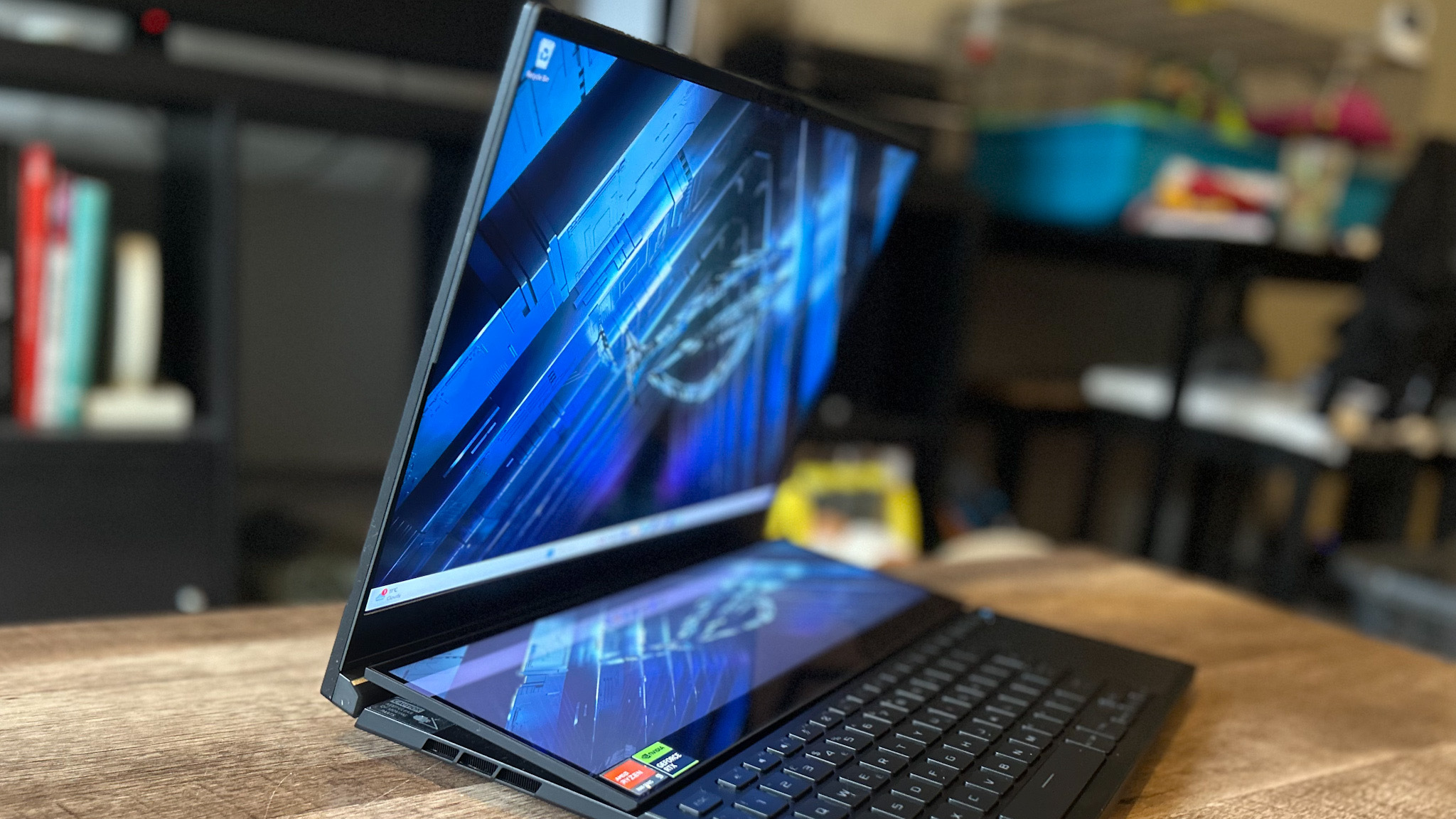
This is the first time I've seen the fps counter stay above 200 for the duration of a benchmark.
Everything is lightning fast here, whether I'm running four RAM-hungry Chrome tabs for work or keeping an eye on messaging while barrelling through Apex Legends. The amount of work that CPU and GPU are doing is astounding, and - when set to Performance mode - the fan noise could fool you into thinking it was easy. Turbo mode does kick things up a notch, and I did find myself reaching for a gaming headset to avoid distraction, but the boost in performance was well worth it.
The industry benchmarks below are impressive when taken in Performance, but I was able to push Fire Strike up to a whopping 40,844 and Time Spy to 18,245 when hitting that Armoury Crate Turbo button.
| Benchmark | Asus ROG Zephyrus Duo 16 | Asus ROG Zephyrus M16 | Asus ROG Strix Scar 16 |
|---|---|---|---|
| Configuration | AMD Ryzen 9 7945HX / RTX 4090 | Intel i9-13900H / RTX 4090 | Intel i9-13980HX / RTX 4080 |
| Time Spy | 15,713 | 14,608 | 17,611 |
| Fire Strike | 36,768 | 31,877 | 32,876 |
| PC Mark 10 | 8,146 | 7,947 | 7,590 |
| Cinebench R23 | Multi: 31,588 | Multi: 17,333 | Multi: 26,032 |
Considering even with those fans somewhat limited I was still consistently beating the Asus ROG Zephyrus M16 across all benchmarks - while running a second screen - that's an insane result. The Duo was also giving the beefier ROG Strix Scar a run for its money when it came to Fire Strike and PC Mark 10 tests as well.
These numbers show AMD's latest generation of processors in a particularly shiny light. These are astounding results, putting Intel's similar tier options well behind. Of course, every component is going to perform differently in every laptop, but there's no denying the sheer power of the Ryzen 7-HX.
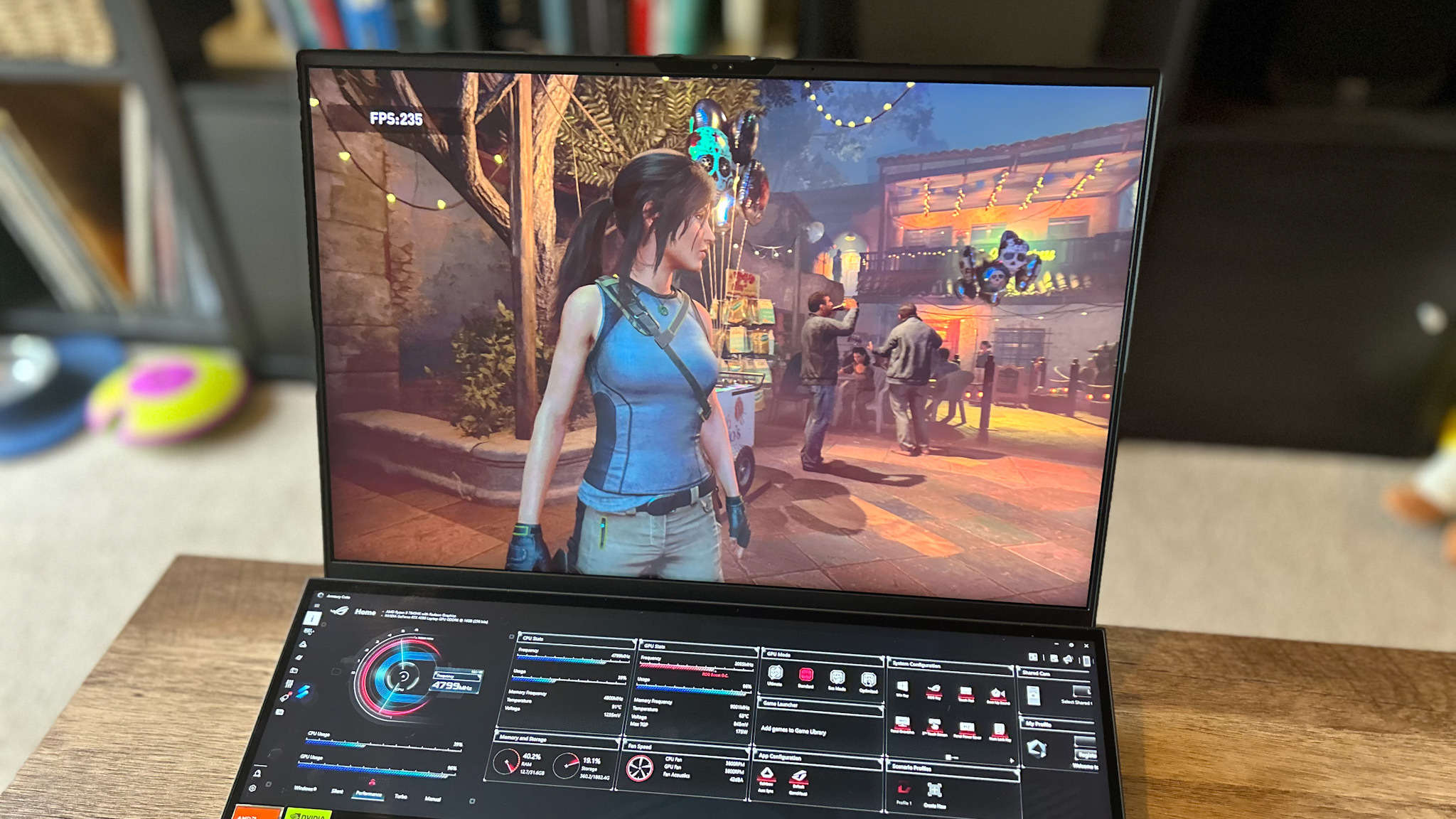
Aside from that CPU, I have to believe a lot of this performance boost comes from ventilation, if only because those numbers did drop when slightly closing the lid (and therefore reducing the angle of the second screen). Temperatures were remarkably comfortable throughout my testing, and even after multiple stress tests, I was able to benchmark figures similar to those returned at the start of a testing session.
The story is much the same in-game. Shadow of the Tomb Raider was consistently netting over 200fps in 1080p. Yes, it's an easy game for an Nvidia GPU to hit quickly - and I was running it in a reduced resolution - but this is the first time I've seen the fps counter stay above 200 for the duration of a benchmark.
| Benchmark Test | 1080p | 1440p (2560 x 1600) |
|---|---|---|
| Shadow of the Tomb Raider | High: 219fps | Highest: 211fps | High: 189fps | Highest: 182fps |
| Total War: Three Kingdoms | High: 190fps | Ultra: 158fps | High: 134fps | Highest: 97fps |
| Metro Exodus | High: 175fps | Ultra: 172fps | High: 129fps | Ultra: 121fps |
| Red Dead Redemption 2 | Balanced: 163fps | Highest: 153fps | Balanced: 158fps | Highest: 120fps |
| The Division 2 | High: 203fps | Ultra: 192fps | High: 187fps | Ultra: 179fps |
Hitting three-figure fps no matter what's thrown at it, the Zephyrus Duo holds its own on the battlefield. It outperformed both other Asus laptops I was comparing against in my own testing and is by far the best-performing machine on paper. However, I did raise my eyebrows at the blue screen of death a couple of times during my testing.
I rarely experience crashes when testing gaming laptops, and I struggled to find rhyme or reason behind the Duo's occasional blip. However, on more than one occasion, and only ever when using the laptop for work, the machine would either freeze indefinitely or completely shut down, cue the smug 'Windows encountered a problem' message. As mentioned above, temperatures were always well within safe - impressively low - boundaries and everything was up to date. Whether a component wasn't quite seated perfectly or the power supply was waning, I'll never quite know. It certainly wasn't enough for me not to trust the device as a whole, and I would still certainly recommend it for a work setting.
Should you buy the Asus ROG Zephyrus Duo 16?
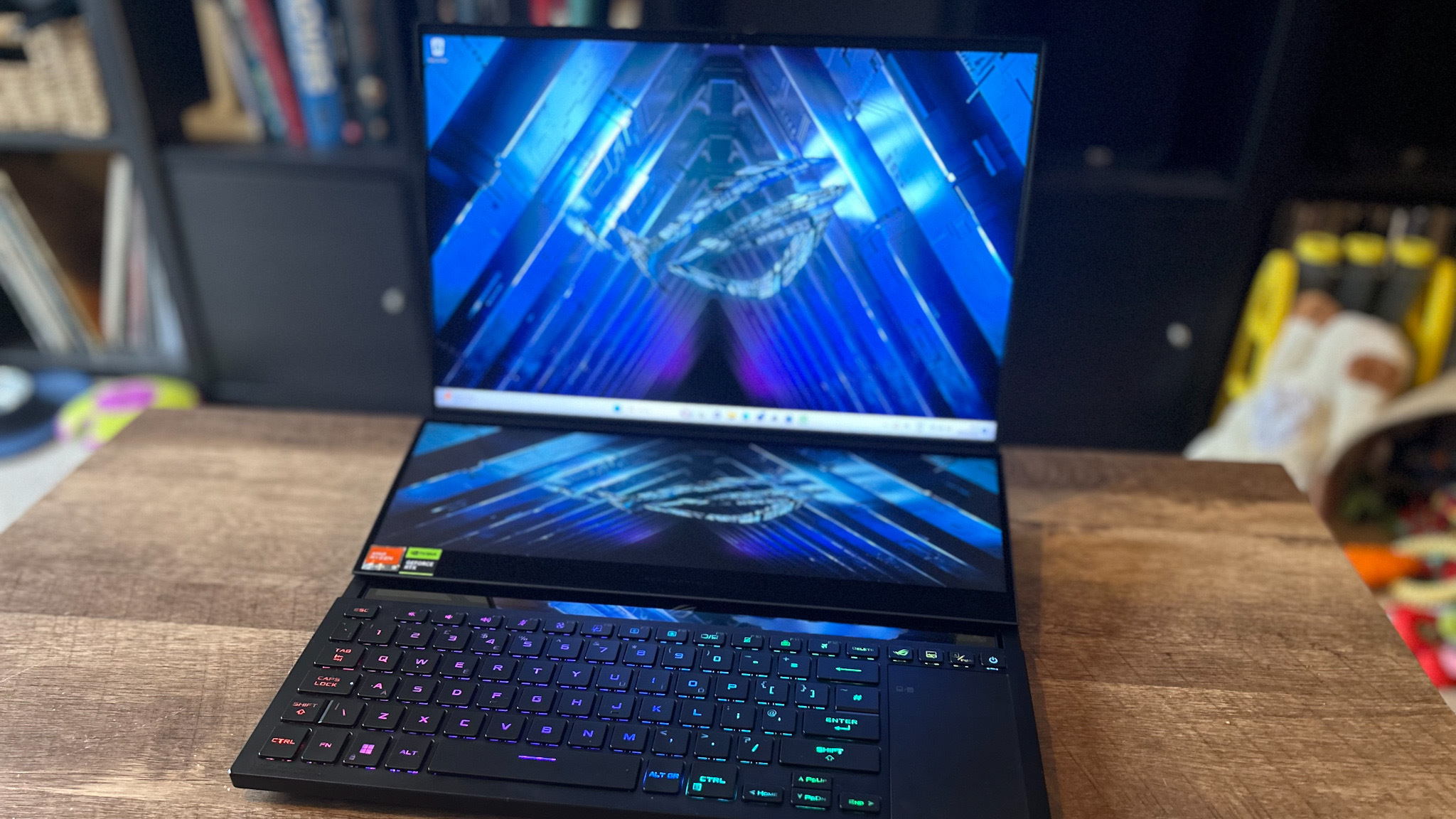
I had more fun testing the Asus ROG Zephyrus Duo 16 than I have any other gaming laptop in a long time. That's a testament to the almost-seamless integration of the second screen and incredible power under the hood. This isn't just any old gaming laptop, this is about as versatile as they come.
If I had the cash to spare you can bet I'd be out buying one tomorrow.
However, not everyone is going to get the most out of this unique build. The second screen just isn't going to justify itself for those after a device created purely for play. If you're not going to be using the Duo for content creation, everyday work, or streaming, I'd recommend investing more in a machine with a greater investment in the keyboard, or one that works harder to bring the overall weight down. That's if you're set on spending top budget prices - anyone who won't use the second screen will also be able to find similar specs in a slightly cheaper laptop (if not now, then in a few months' time).
Of course, that's a tricky recommendation because the Duo just performs so, so well. Those set on spending big would do well to consider this two-faced beauty, even if there's just a chance of using it for more than play in the future. If I had the cash to spare you can bet I'd be out buying one tomorrow.
Buy the Asus ROG Zephyrus Duo if:
You've got a lot of budget to play with
You want a machine for work and play
You don't need a lightweight laptop
You want high-end performance without a bulky feel
How we tested the Asus ROG Zephyrus Duo
I used the Asus ROG Zephyrus Duo as my primary work, play, and binge-watching laptop for a period of two weeks. I used the device daily for all work, with gaming sessions across Planet Coaster, Borderlands: The Pre-Sequel, Apex Legends, Resident Evil: Village, Doom Eternal, and The Sims 4. During this time I also stress tested in a variety of resolutions and graphical settings in Shadow of the Tomb Raider, Total War: Three Kingdoms, Metro Exodus, Red Dead Redemption 2, and The Division 2. For more information on how we test gaming laptops, be sure to check out the full GamesRadar+ Hardware Policy.
We're also rounding up all the best Razer laptops and the best Alienware laptops if you're keen to try a different brand. Or take a look at the best gaming PCs if you're after something more permanent.

Managing Editor of Hardware at GamesRadar+, I originally landed in hardware at our sister site TechRadar before moving over to GamesRadar. In between, I've written for Tom’s Guide, Wireframe, The Indie Game Website and That Video Game Blog, covering everything from the PS5 launch to the Apple Pencil. Now, i'm focused on Nintendo Switch, gaming laptops (and the keyboards, headsets and mice that come with them), PS5, and trying to find the perfect projector.
